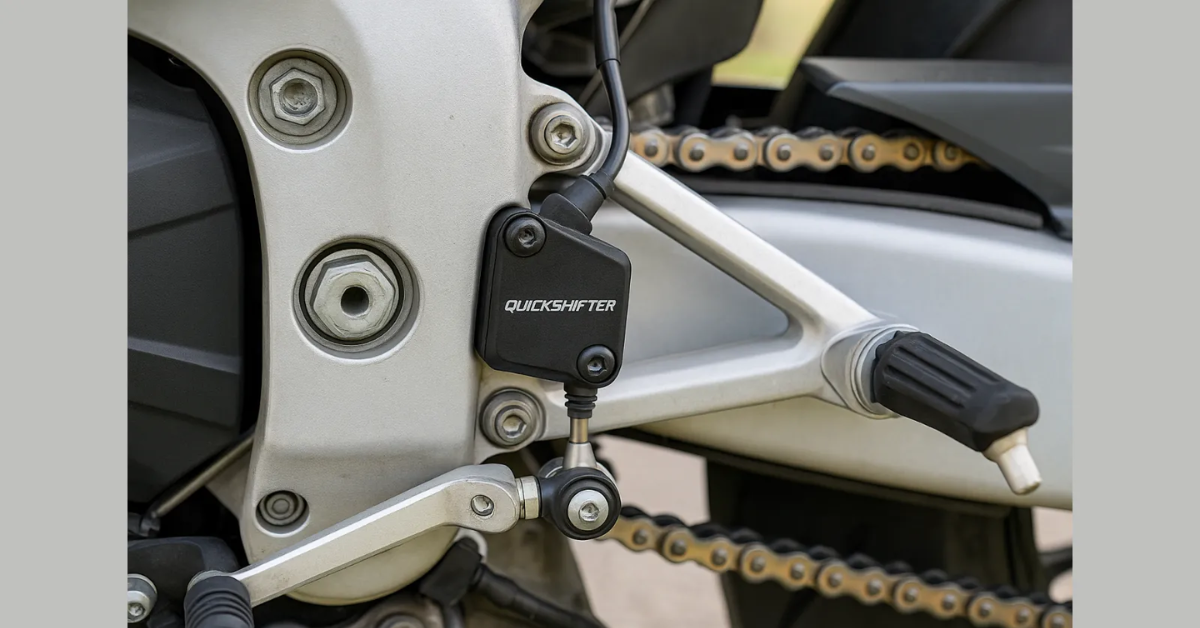Motorcycling has evolved a lot over the years, and one of the coolest features now making its way into both premium and mid-range bikes is the Quickshifter. If you’ve ever wondered how racers manage to shift gears at lightning speed without even touching the clutch, the answer lies in this technology.
In this blog, we’ll break down what a quickshifter in bikes is, how it works, the benefits it offers, and how you can use it effectively in everyday riding.
✅ What Is a Quickshifter in Bikes?
A quickshifter is an electronic device that allows the rider to shift gears without using the clutch or rolling off the throttle. It works with the bike’s ECU (Engine Control Unit) to momentarily cut the ignition or fuel supply, reducing load on the gearbox and allowing a smoother gear change.
- Traditionally, riders need to close the throttle, pull the clutch, shift gears, and then open the throttle again.
- With a quickshifter, you can simply press the gear lever up or down, and the system will handle the process in milliseconds.
👉 In simple words: A quickshifter lets you shift gears faster, smoother, and without extra effort.
✅ How Does a Quickshifter Work?
The working mechanism of a quickshifter is both simple and advanced:
- Gear Lever Sensor – The quickshifter has a sensor attached to the gear lever. When you apply pressure to shift, it sends a signal to the ECU.
- ECU Intervention – The ECU cuts ignition or fuel injection for a fraction of a second (usually 50-80 milliseconds).
- Load Reduction – This short interruption reduces engine load on the gearbox.
- Gear Shift – With reduced stress, the new gear slides in smoothly without using the clutch.
Some modern bikes also have bi-directional quickshifters, which means they work for both upshifts and downshifts.
✅ Types of Quickshifters
- Upshift Quickshifter – Allows clutchless gear shifting only when moving to a higher gear.
- Downshift Quickshifter (Auto-Blipper) – Advanced systems that allow clutchless downshifts. The ECU adds a quick throttle blip to match engine revs with the lower gear.
- Bi-Directional Quickshifter – Works both ways (up and down), offering the smoothest riding experience.
✅ Benefits of Quickshifter in Bikes
A quickshifter is not just about speed—it adds convenience and safety too. Here are the main benefits:
1. Faster Acceleration
Since you don’t need to roll off the throttle or use the clutch, the bike accelerates faster—very useful in racing and highway overtakes.
2. Smoother Gear Shifts
The system ensures minimal jerks and smooth gear transitions, improving overall ride comfort.
3. Less Rider Fatigue
No constant clutch pulling means your left hand relaxes, especially in stop-go traffic and long rides.
4. Better Safety During Overtaking
Quickshifters reduce the time spent during overtakes, which can be critical on highways.
5. Reduced Wear on Clutch
Since the clutch is used less often, it reduces wear and tear, extending its lifespan.
✅ How to Use a Quickshifter Properly?
Using a quickshifter is simple, but a few things can make your experience better and safer:
- Apply Firm Pressure – Don’t half-press the gear lever. Apply steady, firm pressure for a clean shift.
- Keep the Throttle Steady – Maintain throttle while shifting; no need to roll off.
- Use in Higher RPMs – Quickshifters work best when the bike is revving higher. At very low speeds or low RPM, they may feel rough.
- Avoid in Neutral-to-First Gear – Use the clutch for starting from a stop; quickshifters are designed for gear-to-gear changes while moving.
- Downshift Smoothly – If you have a bi-directional quickshifter, let the system rev-match automatically; don’t force it.
✅ Is a Quickshifter Good for Beginners?
- For new riders, it can make biking easier and more fun by removing the hassle of constant clutch use.
- However, beginners should still learn manual clutch control since not all bikes come with quickshifters.
- For daily commuting in cities, it’s convenient but not essential. For touring and racing, it’s a game-changer.
✅ Bikes in India That Offer Quickshifters in 2025
Many premium bikes now come with factory-fitted quickshifters, while mid-range bikes often offer them as optional. Some examples include:
- KTM Duke and RC series (250cc & above)
- TVS Apache RR 310 BTO edition
- Yamaha R3 & MT-03 (higher trims)
- BMW G 310 RR & G 310 R
- Kawasaki Ninja and Z series
- Triumph Street Triple and Daytona
This shows how quickshifter technology is gradually becoming mainstream in India.
✅ Tips to Maintain Your Quickshifter
- Get it checked during regular servicing.
- Ensure the gear lever sensor is calibrated.
- Don’t misuse it at very low speeds.
- Keep your bike’s ECU software updated.
🏍️ Conclusion
A quickshifter in bikes is no longer just a racing technology—it’s becoming a standard feature even in mid-range motorcycles in India. It makes gear shifting faster, smoother, and more convenient, enhancing both performance and safety.
If you’re someone who loves spirited riding, long-distance touring, or simply wants a premium riding feel, a bike with a quickshifter will transform your experience.
However, always remember: while quickshifters add comfort, knowing the basics of manual clutch gear shifting is still important for every motorcyclist.

